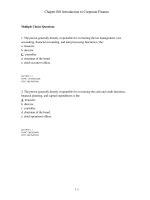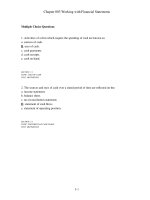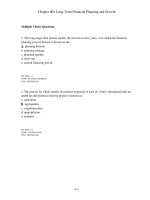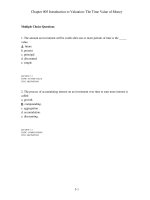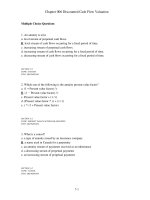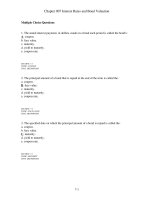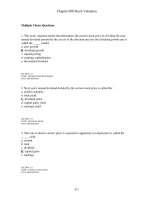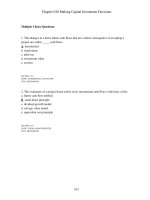Test bank corporate finance 8e ros chap010
Bạn đang xem bản rút gọn của tài liệu. Xem và tải ngay bản đầy đủ của tài liệu tại đây (228.38 KB, 54 trang )
Chapter 010 Making Capital Investment Decisions
Multiple Choice Questions
1. The changes in a firm's future cash flows that are a direct consequence of accepting a
project are called _____ cash flows.
A. incremental
b. stand-alone
c. after-tax
d. net present value
e. erosion
SECTION: 10.1
TOPIC: INCREMENTAL CASH FLOWS
TYPE: DEFINITIONS
2. The evaluation of a project based solely on its incremental cash flows is the basis of the:
a. future cash flow method.
B. stand-alone principle.
c. dividend growth model.
d. salvage value model.
e. equivalent cost principle.
SECTION: 10.1
TOPIC: STAND-ALONE PRINCIPLE
TYPE: DEFINITIONS
3. A cost that has already been incurred and cannot be recouped is a(n):
a. salvage value expense.
b. net working capital expense.
C. sunk cost.
d. opportunity cost.
e. erosion cost.
SECTION: 10.2
TOPIC: SUNK COSTS
TYPE: DEFINITIONS
10-1
Chapter 010 Making Capital Investment Decisions
4. The most valuable investment given up if an alternative investment is chosen is a(n):
a. salvage value expense.
b. net working capital expense.
c. sunk cost.
D. opportunity cost.
e. erosion cost.
SECTION: 10.2
TOPIC: OPPORTUNITY COSTS
TYPE: DEFINITIONS
5. Erosion is best described as:
a. expenses that have already been incurred and cannot be reversed.
b. net working capital expenses.
C. the cash flows of a new project that come at the expense of a firm's existing cash flows.
d. the next alternative that is forfeited when a fixed asset is utilized for a project.
e. the differences in a firm's cash flows with and without a particular project.
SECTION: 10.2
TOPIC: EROSION
TYPE: DEFINITIONS
6. A pro forma financial statement is one that:
A. projects future years' operations.
b. is expressed as a percentage of the total assets of the firm.
c. is expressed as a percentage of the total sales of the firm.
d. is expressed relative to a chosen base year's financial statement.
e. reflects the past and current operations of a firm.
SECTION: 10.3
TOPIC: PRO FORMA FINANCIAL STATEMENTS
TYPE: DEFINITIONS
10-2
Chapter 010 Making Capital Investment Decisions
7. The depreciation method currently allowed under U.S. tax law governing the accelerated
write-off of property under various lifetime classifications is called:
a. FIFO.
B. MACRS.
c. straight-line depreciation.
d. sum-of-years depreciation.
e. erosion.
SECTION: 10.4
TOPIC: MACRS DEPRECIATION
TYPE: DEFINITIONS
8. The tax savings generated as a result of a firm's depreciation expense is called the:
a. aftertax depreciation savings.
b. depreciable basis.
C. depreciation tax shield.
d. operating cash flow.
e. aftertax salvage value.
SECTION: 10.5
TOPIC: DEPRECIATION TAX SHIELD
TYPE: DEFINITIONS
9. The annual annuity stream of payments with the same present value as a project's costs is
called the project's _____ cost.
a. incremental
b. sunk
c. opportunity
d. erosion
E. equivalent annual
SECTION: 10.6
TOPIC: EQUIVALENT ANNUAL COST
TYPE: DEFINITIONS
10-3
Chapter 010 Making Capital Investment Decisions
10. Lester's Dairy gathers and processes cow's milk for distribution to retail outlets. Lester's is
currently considering processing goat's milk as well. Which one of the following is most apt
to be an incremental cash flow related to the goat milk project?
a. processing the goat's milk in the same building as the cow's milk
b. utilizing the same pasteurizing equipment to process both kinds of milk
C. purchasing additional milk jugs to handle the increased volume of milk
d. researching the market to ascertain if goat milk sales might be profitable before deciding to
proceed
e. reducing the projected interest expense by assuming the proceeds of the goat milk sales will
reduce the outstanding debt
SECTION: 10.1 AND 10.2
TOPIC: INCREMENTAL CASH FLOW
TYPE: CONCEPTS
11. Russell's of Westerfield is a furniture store which is considering offering carpet for sale.
Which of the following should be considered incremental cash flows of theproject?
I. utilizing the credit offered by a carpet supplier to build an initial inventory
II. granting credit to a customer so she can purchase carpet and pay for it at a later date
III. borrowing money from a bank to fund the carpet project
IV. purchasing carpet to hold in inventory
a. I and II only
b. III and IV only
C. I, II, and IV only
d. II, III, and IV only
e. I, II, III, and IV
SECTION: 10.1 AND 10.2
TOPIC: INCREMENTAL CASH FLOW
TYPE: CONCEPTS
10-4
Chapter 010 Making Capital Investment Decisions
12. The stand-alone principle advocates that project analysis should focus on _____ costs.
a. sunk
b. total
c. variable
D. incremental
e. fixed
SECTION: 10.1
TOPIC: STAND-ALONE PRINCIPLE
TYPE: CONCEPTS
13. Sunk costs include any cost that will:
a. change if a project is undertaken.
b. be incurred if a project is accepted.
C. not change as it was previously incurred and cannot be recouped.
d. be paid to a third party and cannot be recouped.
e. occur if a project is accepted and once incurred, cannot be recouped.
SECTION: 10.2
TOPIC: SUNK COST
TYPE: CONCEPTS
14. You spent $600 last week repairing the brakes on your car. Now, the starter is acting up
and you are trying to decide whether to fix the starter or trade the car in for a newer model. In
analyzing the starter situation, the $600 you spent fixing the brakes is a(n) _____ cost.
a. opportunity
b. fixed
c. incremental
d. erosion
E. sunk
SECTION: 10.2
TOPIC: SUNK COST
TYPE: CONCEPTS
10-5
Chapter 010 Making Capital Investment Decisions
15. Which one of the following best illustrates erosion as it relates to project analysis?
a. providing both ketchup and mustard for your customer's use
b. repairing the roof of your hamburger stand because of water damage
C. selling less hamburgers because you also started selling hot dogs
d. opting to sell french fries but not onion rings
e. opting to increase your work force by hiring two part-time employees
SECTION: 10.2
TOPIC: EROSION
TYPE: CONCEPTS
16. Which of the following are examples of erosion?
I. the loss of current sales due to increased competition in the product market
II. the loss of current sales because your chief competitor just opened a store across the street
from your store
III. the loss of current sales due to a new product which you recently introduced
IV. the loss of current sales due to a new product recently introduced by your competitor
A. III only
b. III and IV only
c. I, III, and IV only
d. II and IV only
e. I, II, III, and IV
SECTION: 10.2
TOPIC: EROSION
TYPE: CONCEPTS
10-6
Chapter 010 Making Capital Investment Decisions
17. You are considering the purchase of new equipment. Your analysis includes the
evaluation of two machines which have differing initial and ongoing costs and differing lives.
Whichever machine is purchased will be replaced at the end of its useful life. You should
select the machine which has the:
a. longest life.
b. highest annual operating cost.
c. lowest annual operating cost.
d. highest equivalent annual cost.
E. lowest equivalent annual cost.
SECTION: 10.6
TOPIC: EQUIVALENT ANNUAL COSTS
TYPE: CONCEPTS
10-7
Chapter 010 Making Capital Investment Decisions
18. The bid price is:
a. an aftertax price.
b. the aftertax contribution margin.
c. the highest price you should charge if you want the project.
d. the only price you can bid if the project is to be profitable.
E. the minimum price you should charge if you want to financially breakeven.
SECTION: 10.6
TOPIC: BID PRICE
TYPE: CONCEPTS
19. Which of the following should be included in the analysis of a project?
I. sunk costs
II. opportunity costs
III. erosion costs
IV. noncash expenses
a. I and II only
b. III and IV only
c. II and III only
D. II, III, and IV only
e. I, II, and IV only
SECTION: 10.2
TOPIC: TYPES OF COSTS
TYPE: CONCEPTS
10-8
Chapter 010 Making Capital Investment Decisions
20. All of the following are related to a proposed project. Which should be included in the
cash flow at time zero?
I. initial inventory increase of $2,500
II. loan of $125,000 to commence a project
III. depreciation tax shield of $1,100
IV. initial purchase of $6,500 of fixed assets
a. I and II only
B. I and IV only
c. II and IV only
d. I, II, and IV only
e. I, II, III, and IV
SECTION: 10.4
TOPIC: NET WORKING CAPITAL
TYPE: CONCEPTS
21. Changes in the net working capital:
A. can affect the cash flows of a project every year of the project's life.
b. only affect the initial cash flows of a project.
c. are included in project analysis only if they represent cash outflows.
d. are generally excluded from project analysis due to their irrelevance to the total project.
e. affect the initial and the final cash flows of a project but not the cash flows of the middle
years.
SECTION: 10.4
TOPIC: NET WORKING CAPITAL
TYPE: CONCEPTS
22. Which one of the following is a cash inflow? Ignore any tax effects.
a. a decrease in accounts payable
b. an increase in inventory
C. a decrease in accounts receivable
d. depreciation expense
e. an increase in fixed assets
SECTION: 10.4
TOPIC: NET WORKING CAPITAL
TYPE: CONCEPTS
10-9
Chapter 010 Making Capital Investment Decisions
23. Net working capital:
a. can be ignored in project analysis because any expenditure is normally recouped by the end
of the project.
b. requirements generally, but not always, create a cash inflow at the beginning of a project.
c. expenditures commonly occur at the end of a project.
D. is frequently affected by the additional sales generated by a new project.
e. is the only expenditure where at least a partial recovery can be made at the end of a project.
SECTION: 10.4
TOPIC: NET WORKING CAPITAL
TYPE: CONCEPTS
24. The operating cash flows for a cost reduction project:
a. cannot be computed since there is no incremental sales revenue.
b. will equal zero because there will be no incremental sales.
c. can only be analyzed if all the sales and expenses of a firm are considered.
D. must consider the depreciation tax shield.
e. will always be negative values.
SECTION: 10.3
TOPIC: PRO FORMA INCOME STATEMENT
TYPE: CONCEPTS
25. Pro forma statements for a proposed project should:
I. be compiled on a stand-alone basis.
II. include all the incremental cash flows related to a project.
III. generally exclude interest expense.
IV. include all project-related fixed asset acquisitions and disposals.
a. I and II only
b. II and III only
c. I, II, and IV only
d. II, III, and IV only
E. I, II, III, and IV
SECTION: 10.3
TOPIC: PRO FORMA STATEMENTS
TYPE: CONCEPTS
10-10
Chapter 010 Making Capital Investment Decisions
26. Which one of the following statements is correct?
a. Project analysis should only include the cash flows which affect the income statement.
B. A project can create a positive operating cash flow without affecting sales.
c. For the majority of projects that increase sales, there will be a cash outflow related to net
working capital that occurs at the end of the project.
d. Interest expense should always be included as a cash outflow when analyzing a project.
e. The opportunity cost of a company-owned building that is going to be used in a new project
should be included as a cash inflow to the project.
SECTION: 10.3
TOPIC: PROJECT CASH FLOWS
TYPE: CONCEPTS
27. A company which utilizes the MACRS system of depreciation:
a. will have equal depreciation costs each year of an asset's life.
B. will have a greater tax shield in year two of a project than they would have if the firm had
opted for straight-line depreciation.
c. can depreciate the cost of land, if they so desire.
d. will expense less than the entire cost of an asset over the asset's class life.
e. cannot expense any of the cost of a new asset during the first year of the asset's life.
SECTION: 10.4
TOPIC: MACRS
TYPE: CONCEPTS
10-11
Chapter 010 Making Capital Investment Decisions
28. Wiley Electric just purchased some MACRS 5-year property at a cost of $118,000. Which
one of the following will correctly give you the book value of this equipment at the end of
year 3?
a. $118,000 / (1 + .20 + .32 + .192)
B. $118,000 (1 .20 .32 .192)
c. $118,000 (.20 + .32 + .192)
d. {[$118,000 (1 .20)] (1 .32)}
e. $118,000 /{[(1.20 / 1.32)] / 1.192}
(1
.192)
SECTION: 10.4
TOPIC: MACRS
TYPE: CONCEPTS
10-12
Chapter 010 Making Capital Investment Decisions
29. Jenningston Manor just purchased some equipment at a cost of $58,000. What is the
proper methodology for computing the depreciation expense for year 2 if the equipment is
classified as 5-year property for MACRS?
a. $58,000 (1 .20) .32
b. $58,000 / (1 .20 .32)
c. $58,000 1.32
d. $58,000 (1 .32)
E. $58,000 .32
SECTION: 10.4
TOPIC: MACRS
TYPE: CONCEPTS
10-13
Chapter 010 Making Capital Investment Decisions
30. The book value of a fixed asset must be used in the computation of which one of the
following?
a. annual tax shield
B. tax due on the sale of a fixed asset
c. operating cash flow
d. change in net working capital
e. MACRS depreciation
SECTION: 10.4
TOPIC: BOOK VALUE
TYPE: CONCEPTS
31. The book value of equipment will:
a. remain constant over the life of the equipment.
b. vary in response to changes in the market value.
c. decrease at a constant rate when MACRS depreciation is used.
d. increase over the taxable life of an asset.
E. decrease slower under straight-line depreciation than under MACRS.
SECTION: 10.4
TOPIC: BOOK VALUE
TYPE: CONCEPTS
32. The aftertax salvage value = Sales price:
a. + (Sales price Book value) T.
b. + (Sales price Book value) (1 T).
C. (Sales price Book value) T.
d. (Sales price Book value) (1 T).
e. (1 T).
SECTION: 10.4
TOPIC: SALVAGE VALUE
TYPE: CONCEPTS
10-14
Chapter 010 Making Capital Investment Decisions
33. The pre-tax salvage value of an asset is equal to the:
a. book value if straight-line depreciation is used.
b. book value if MACRS depreciation is used.
c. market value minus the book value.
d. book value minus the market value.
E. market value.
SECTION: 10.4
TOPIC: SALVAGE VALUE
TYPE: CONCEPTS
34. A project's operating cash flow will increase when:
a. the tax rate increases.
b. sales decrease.
c. interest expense decreases.
D. depreciation expense increases.
e. earnings before interest and taxes decreases.
SECTION: 10.5
TOPIC: PROJECT OCF
TYPE: CONCEPTS
35. The cash flows of a project should:
a. be computed on a pre-tax basis.
b. include all sunk costs and opportunity costs.
C. include the effects of erosion.
d. be included in the year when the related expense or income is recognized by GAAP.
e. include all financing costs related to the project.
SECTION: 10.2
TOPIC: PROJECT CASH FLOWS
TYPE: CONCEPTS
10-15
Chapter 010 Making Capital Investment Decisions
36. Which one of the following is correct method for computing the operating cash flow of a
project assuming that the interest expense is equal to zero?
a. EBIT + D
b. EBIT T
C. NI + D
d. (Sales Costs) (1 D) (1 T)
e. (Sales Costs) (1 T)
SECTION: 10.5
TOPIC: PROJECT OCF
TYPE: CONCEPTS
37. The cash flows of a project should exclude the incremental changes in which one of the
following accounts?
a. taxes
b. accounts payable
c. fixed assets
D. long-term debt
e. depreciation
SECTION: 10.2
TOPIC: PROJECT CASH FLOWS
TYPE: CONCEPTS
38. The bottom-up approach to computing the operating cash flow applies only when:
a. both the depreciation expense and the interest expense are equal to zero.
B. the interest expense is equal to zero.
c. the project is a cost-cutting project.
d. no fixed assets are required for a project.
e. taxes are ignored and the interest expense is equal to zero.
SECTION: 10.5
TOPIC: BOTTOM-UP OCF
TYPE: CONCEPTS
10-16
Chapter 010 Making Capital Investment Decisions
39. The top-down approach to computing the operating cash flow:
A. ignores all noncash items.
b. applies only if a project increases sales.
c. can only be used if the entire cash flows of a firm are analyzed.
d. is equal to sales costs taxes + depreciation.
e. includes the interest expense related to a project.
SECTION: 10.5
TOPIC: TOP-DOWN OCF
TYPE: CONCEPTS
40. Increasing which one of the following will increase the operating cash flow?
a. erosion
b. taxes
c. fixed expenses
d. salaries
E. depreciation
SECTION: 10.5
TOPIC: TAX SHIELD
TYPE: CONCEPTS
41. Which one of the following creates a tax shield?
a. dividend payment
b. increase in accounts payable
c. decrease in inventory
D. noncash expense
e. sunk cost
SECTION: 10.5
TOPIC: TAX SHIELD
TYPE: CONCEPTS
10-17
Chapter 010 Making Capital Investment Decisions
42. A project which improves the operating efficiency of a firm but which generates no
revenue is referred to as a(n) _____ project.
a. sunk cost
b. opportunity
C. cost-cutting
d. erosion
e. cashless
SECTION: 10.6
TOPIC: COST-CUTTING
TYPE: CONCEPTS
43. Which of the following statements are correct regarding the analysis of a cost-cutting
project that has an initial cash outflow for fixed assets?
I. The costs shown on the pro forma income statement represent a cash inflow.
II. The depreciation expense related to the fixed assets creates a tax shield.
III. The project operating cash flow can be computed as (Costs
Taxes).
IV. The earnings before interest and taxes are equal to the costs.
a. I and II only
b. III and IV only
c. I and III only
d. II and IV only
E. I, II, and III only
SECTION: 10.6
TOPIC: COST-CUTTING
TYPE: CONCEPTS
10-18
Chapter 010 Making Capital Investment Decisions
44. Which one of the following statements is correct concerning bid prices?
a. The competitor who wins the bid is the one who submits the highest bid price.
B. The winning bid may be at a price that is below break-even especially if there is a related
aftermarket for the product.
c. A bid price is computed based on 110 percent of a firm's normal required return.
d. A bid price should be computed based solely on the operating cash flows of the proposed
project.
e. A bid price should be computed based on a zero percent required rate of return.
SECTION: 10.6
TOPIC: BID PRICE
TYPE: CONCEPTS
10-19
Chapter 010 Making Capital Investment Decisions
45. Frederick is comparing machines to determine which one to purchase. The machines sell
for differing prices, have differing operating costs, differing machine lives, and will be
replaced when worn out. These machines should be compared using:
a. their internal rates of return.
b. both net present value and the internal rate of return.
C. their effective annual costs.
d. the depreciation tax shield approach.
e. the replacement parts approach.
SECTION: 10.6
TOPIC: EQUIVALENT ANNUAL COST
TYPE: CONCEPTS
46. The equivalent annual cost method is useful in determining:
a. which one of two machines to purchase if the machines are mutually exclusive, have
differing lives, and are a one-time purchase.
b. the tax shield benefits of depreciation given the purchase of new assets for a project.
c. operating cash flows for cost-cutting projects of unequal duration.
d. which one of two investments to accept when the investments have different required rates
of return.
E. which one of two machines to purchase when the machines are mutually exclusive, have
different machine lives, and will be replaced once they are worn out.
SECTION: 10.6
TOPIC: EQUIVALENT ANNUAL COST
TYPE: CONCEPTS
10-20
Chapter 010 Making Capital Investment Decisions
47. Justin's Manufacturing purchased a lot in Lake City ten years ago at a cost of $790,000.
Today, that lot has a market value of $1.2 million. At the time of the purchase, the company
spent $100,000 to grade the lot and another $20,000 to build a small garage on the lot to
house additional equipment. The company now wants to build a new facility on the site. The
building cost is estimated at $1.7 million. What amount should be used as the initial cash flow
for this project?
a. $2,490,000
b. $2,610,000
C. $2,900,000
d. $3,020,000
e. $3,690,000
CF0 =
$1,200,000 + ( $1,700,000) =
$2,900,000
AACSB TOPIC: ANALYTIC
SECTION: 10.2
TOPIC: RELEVANT CASH FLOWS
TYPE: PROBLEMS
48. McLain, Inc. currently produces boat sails and is considering expanding its operations to
include awnings for homes and travel trailers. The company owns land beside its current
manufacturing facility that could be used for the expansion. The company bought this land
eight years ago at a cost of $500,000. At the time of purchase, the company paid $70,000 to
level out the land so it would be suitable for future use. Today, the land is valued at $750,000.
The company currently has some unused equipment which it currently owns valued at
$40,000. This equipment could be used for producing awnings if $10,000 is spent for
equipment modifications. Other equipment costing $400,000 will also be required. What is
the amount of the initial cash flow for this expansion project?
a. $870,000
b. $1,020,000
C. $1,200,000
d. $1,620,000
e. $2,020,000
CF0 =
$750,000 + ( $40,000) + ( $10,000) + ( $400,000) =
AACSB TOPIC: ANALYTIC
SECTION: 10.2
TOPIC: RELEVANT CASH FLOWS
TYPE: PROBLEMS
10-21
$1,200,000
Chapter 010 Making Capital Investment Decisions
49. Keller Co. paid $50,000, in cash, for a piece of equipment four years ago. At the
beginning of the year, the company spent $5,000 to update the equipment with the latest
technology. The company no longer uses this equipment in their current operations and has
received an offer of $75,000 from a firm who would like to purchase it. Keller Co. is debating
whether to sell the equipment or to expand their operations such that the equipment can be
used. When evaluating the expansion option, what value, if any, should Keller Co. assign to
this equipment as an initial cost of the project?
a. $0
b. $5,000
c. $50,000
D. $75,000
e. $80,000
CF0 = $75,000
AACSB TOPIC: ANALYTIC
SECTION: 10.2
TOPIC: RELEVANT CASH FLOWS
TYPE: PROBLEMS
50. Elite Design, Inc. sells customized handbags. Currently, they sell 30,000 handbags
annually at an average price of $79 each. They are considering adding a lower-priced line of
handbags which sell for $45 each. Elite Design estimates they can sell 12,000 of the lowerpriced handbags but will sell 4,000 less of the higher-priced handbags by doing so. What is
the amount of the sales that should be used when evaluating the addition of the lower-priced
handbags?
A. $224,000
b. $540,000
c. $856,000
d. $1,234,000
e. $1,514,000
Sales = (12,000
$45)
(4,000
$79) = $224,000
AACSB TOPIC: ANALYTIC
SECTION: 10.2
TOPIC: RELEVANT CASH FLOWS
TYPE: PROBLEMS
10-22
Chapter 010 Making Capital Investment Decisions
51. Expansion, Inc. purchased a building for $485,000 seven years ago. Five years ago,
repairs were made to the building which cost $80,000. The annual taxes on the property are
$30,000. The building has a current market value of $424,000 and a current book value of
$399,000. The building is totally paid for and solely owned by the firm. If the company
decides to assign this building to a new project, what value, if any, should be included in the
initial cash flow of the project for this building?
a. $0
B. $424,000
c. $454,000
d. $485,000
e. $504,000
Opportunity cost = $424,000
AACSB TOPIC: ANALYTIC
SECTION: 10.2
TOPIC: OPPORTUNITY COST
TYPE: PROBLEMS
52. You own a house that you rent for $1,600 a month. The maintenance expenses on the
house average $300 a month. The house cost $110,000 when you purchased it six years ago.
A recent appraisal on the house valued it at $295,000. If you sell the house you will incur
$15,000 in real estate fees. The annual property taxes are $25,000. You are deciding whether
to sell the house or convert it for your own use as a professional office. What value should
you place on this house when analyzing the option of using it as a professional office?
a. $150,000
b. $255,000
C. $280,000
d. $293,100
e. $310,000
Opportunity cost = $295,000
$15,000 = $280,000
AACSB TOPIC: ANALYTIC
SECTION: 10.2
TOPIC: OPPORTUNITY COST
TYPE: PROBLEMS
10-23
Chapter 010 Making Capital Investment Decisions
53. Janson's Auto Parts owns a manufacturing facility that is currently sitting idle. The facility
is located on a piece of land that originally cost $134,000. The facility itself cost $700,000 to
build. As of now, the book value of the land and the facility are $134,000 and $214,000,
respectively. Janson's Auto Parts received a bid of $640,000 for the land and facility last
week. They rejected this bid even though they were told that it is a reasonable offer in today's
market. If Janson's Auto Parts were to consider using this land and facility in a new project,
what cost, if any, should they include in the project analysis?
a. $348,000
B. $640,000
c. $700,000
d. $774,000
e. $834,000
CF0 = $640,000
AACSB TOPIC: ANALYTIC
SECTION: 10.2
TOPIC: OPPORTUNITY COST
TYPE: PROBLEMS
54. Jenna's Home Spa Sales currently sells 2,000 Class A spas, 5,000 Class C spas, and 1,000
deluxe model spas each year. Jenna is considering adding a mid-class spa and expects that if
she does she can sell 2,500 of them. However, if the new spa is added, Jenna expects that her
Class A sales will decline to 1,700 units while the Class C sales decline to 4,500. The sales of
the deluxe model will not be affected. Class A spas sell for an average of $75,000 each. Class
C spas are priced at $25,000 and the deluxe model sells for $100,000 each. The new midrange spa will sell for $50,000. What is the erosion cost?
A. $35,000,000
b. $90,000,000
c. $125,000,000
d. $205,000,000
e. $240,000,000
Erosion cost = [(1,700
2,000)
$75,000] + [(4,500
AACSB TOPIC: ANALYTIC
SECTION: 10.2
TOPIC: EROSION COST
TYPE: PROBLEMS
10-24
5,000)
$25,000] = $35,000,000
Chapter 010 Making Capital Investment Decisions
55. Shelly's Boutique is evaluating a project which will increase annual sales by $70,000 and
annual costs by $40,000. The project will initially require $100,000 in fixed assets which will
be depreciated straight-line to a zero book value over the 5-year life of the project. The
applicable tax rate is 34 percent. What is the operating cash flow for this project?
a. $26,400
B. $26,600
c. $30,000
d. $46,400
e. $46,600
Tax = .34 [$70,000
$3,400 = $26,600
40,000
($100,000 / 5)] = $3,400; OCF = $70,000
$40,000
AACSB TOPIC: ANALYTIC
SECTION: 10.3 AND 10.4
TOPIC: OCF
TYPE: PROBLEMS
56. The Clothing Co. is looking at a project that will require $40,000 in net working capital
and $100,000 in fixed assets. The project is expected to produce annual sales of $90,000 with
associated costs of $60,000. The project has a 10-year life. The company uses straight-line
depreciation to a zero book value over the life of the project. The tax rate is 35 percent. What
is the operating cash flow for this project?
a. $17,000
b. $19,500
C. $23,000
d. $33,000
e. $90,000
Tax = .35 [$90,000
$7,000 = $23,000
60,000
($100,000 / 10)] = $7,000; OCF = $90,000
AACSB TOPIC: ANALYTIC
SECTION: 10.3 AND 10.4
TOPIC: OCF
TYPE: PROBLEMS
10-25
$60,000
